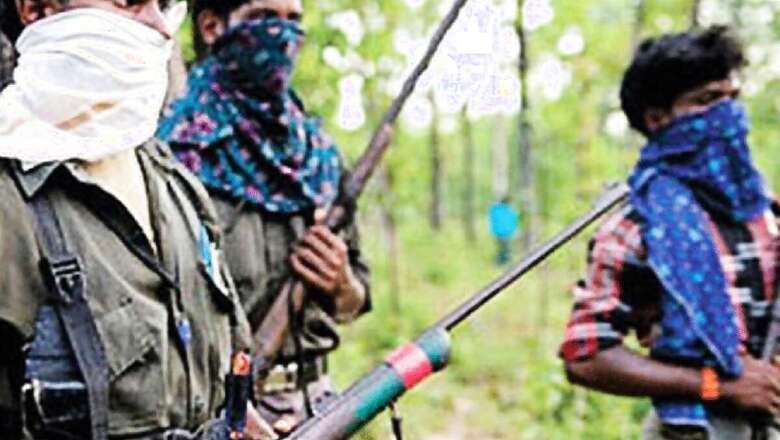
views
The police and the security forces had some good news from the Maoist-affected areas of Sukma district of Chhattisgarh and Gadchiroli district of Maharashtra recently. Three Maoists were killed due to firing by CRPF from its newly established camp at Mukru near Silger village of Sukma. CRPF had to retaliate when the newly established camp, which is in an area dominated by Maoists, faced protests by villagers with some Maoist cadres present in the crowd. They wanted the camp to be closed down but the police/CRPF did not oblige. They attacked the camp and fired gunshots too, leading to this escalation. Whereas the protesters claim that those killed were simple village folks, the police have confirmed after verifying the identity of the dead that they were Maoists who were feeling threatened about their activities in the area due to this newly established camp. In Gadchiroli, the police killed 13 Maoist cadres — many of whom had rewards on their heads — during a routine search operation in the forests of Kotmi in Etapalli tehsil of the district in an encounter. These incidents may not have drawn much national attention, but do have lot of importance as they show a slow and steady domination by the security forces over the Maoists.
Basically, it is a fight between the police and the Maoists about area domination in about 30 districts now (down from about 100 districts earlier), including the above-mentioned districts that are a part of their core areas because of remoteness, difficult terrain, no development and availability of youngsters for recruitment. A majority of the incidents of violence by the Maoists are from these districts, though they have some presence in states such as Bihar, Madhya Pradesh, Odisha, Jharkhand, Telangana and Andhra Pradesh as well. Their activities have been controlled considerably during the last decade — which is a measure of success of the security forces. Earlier, they had, according to some estimates, about 10,000 hardcore armed extremists, but now are left with about 2,000-3,000. Though security forces keep facing setbacks, including a few major ones, on the whole they are succeeding in gaining more territory slowly — which is quickly followed by development projects by states, ably supported by the central government by various steps like more security-related expenditure, attractive surrender-cum-rehabilitation schemes, construction of roads and bridges, and erecting communication towers, among others.
But, as of now, Left-wing extremist cadres are fighting tooth and nail the new strategy of the security forces slowly opening more camps in their areas of domination. In the past few years, the security forces have successfully established many combined camps of local police and central forces. This is an excellent strategy and I have seen this as being very effective in insurgency-hit areas in northeastern India, where I have worked. The best way to fight an enemy is to enter his territory; such a move will be violently resisted, but if you are strong and powerful, the enemy will retreat. This is what has been happening. In such situations, there are bound to be reverses, which have to be taken in stride. But this is the way to succeed as you improve your functioning based on experience. After gaining physical control of the area, the administration takes over for development projects of roads, communication, schools and medical care. It takes care of livelihood and safeguards traditional rights in terms of forest produce and many other related activities of the inhabitants. The grievances of the people must be addressed properly and to their satisfaction. The Maoists have been naturally resisting the establishment of these camps and the protest at the new camp near Silger was a part of that effort. Since villagers are under their control, they can’t refuse their diktat in holding such protests against the establishment of new camps. The poor folk are caught between the security forces and the Maoists.
Another important issue is that the Maoists don’t allow development projects to be undertaken in those areas, and also extort a lot of money from contractors — like in the case of the encounter in Gadchiroli forests, where they had gone to extort money from the contractors of tendu leaves but faced the security forces in a gunfight that led to the loss of 13 of their cadres. To ensure successful completion of development projects like construction and upkeep of roads, bridges, communication lines and towers, and hospitals and school buildings etc., a few peace battalions of armed police should be exclusively raised just to guard the work on the development projects, as was done in Tripura while fighting insurgency. This battle by the government against the Maoists also has to be fought at an ideological level, as their ideology appeals to the simple village folks who are told that they are being exploited by the government and the richer class, and that both have to be overthrown violently. There are many renowned social organisations in the country who can undertake this ideological work in the areas dominated by the Maoists in order to wean the public away from their ideology. A powerful, sustained psy war (psychological war) to influence the people and show them the misdeeds of the Maoists is also needed. In this war, social media should be used extensively, as the new powerful tool for propaganda is being used by the Maoists — ably supported by the Urban Naxals. The concerned state governments, the politicians there, the social activists and other leading persons in different fields should also help in bringing peace in the affected areas. Further, there should be whole-hearted cooperation between the bordering states and the central government.
We are on the road to success against Maoists though the speed is slow. With strong determination and action by all stakeholders, this speed can increase. It’s not an unsurmountable problem.
Read all the Latest News, Breaking News and Coronavirus News here.

















Comments
0 comment